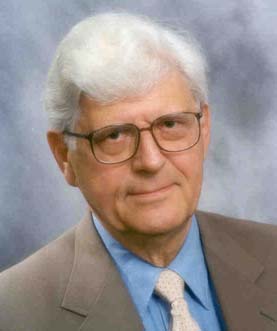Rutgers University Department of Physics and Astronomy
Richard J. Plano Dissertation Prize
The Richard J. Plano Dissertation Prize is given annually to a PhD graduate
who, in the judgment of the physics graduate faculty, wrote the best PhD
dissertation in the past year. The prize, which includes a cash award, was
established by an anonymous donor in honor of Richard J. Plano, who was a
professor of physics at Rutgers until his retirement in 1999. The prizewinner
is announced at the annual Departmental Awards Banquet in April.
Richard J. Plano (1929-2012)
Biographical sketch contributed by Mohan Kalelkar
Richard J. Plano was born on April 15, 1929 in Merrill, Wisconsin. He won a
competitive all-tuition Pepsi-Cola Scholarship, which made it possible for him
to attend the University of Chicago, where he received the AB Degree in 1949,
the BS in 1951, MS in 1953 and his Ph.D. in 1956. He helped develop the first
liquid hydrogen bubble chamber, which he then used for his thesis research into
pion-proton scattering.
He joined the faculty of Columbia University, New York, NY in January, 1956 as
an instructor and was promoted to assistant professor in 1958. While there he
participated in bubble chamber experiments at Nevis Laboratory and Brookhaven
National Laboratory which determined the parity of the neutral pion and the
spin of the lambda hyperon, revealed the properties of the then mysterious
neutral kaon, and produced numerous other results which formed the basis of the
now commonly accepted "Standard Model".
In 1960 he joined the Physics Department at Rutgers as an associate professor
and quickly founded a strong program in high-energy experimental physics,
starting with an advanced facility to analyze bubble chamber photographs. In
1963 he was promoted to full professor and in 1985 to Professor II. His
research was supported by the National Science Foundation, which increased his
annual support each year for 35 years to a maximum of $315,000.
The NSF support included funding for an automatic device (called PEPR) for
scanning and measuring bubble chamber photographs semi-automatically under
computer control. An outgrowth of this effort was one of the first powerful
time-sharing computer systems, which controlled PEPR, analyzed the resulting
data, and was made available to the entire faculty, staff, and graduate student
body starting in 1965. This pioneering computing effort gave the department
impressive computing power at an early stage in the development of computers.
His research using this equipment produced many results of major importance
concerning the strong interactions as well as neutrino interactions. Starting
in 1985, his major interest turned to electron accelerators and he made major
contributions to the SLD detector at Stanford University. During his career,
he used the high energy accelerators at the University of Chicago, Nevis
Laboratory, Brookhaven National Laboratory, Fermilab, CERN, and Stanford
University. More than 200 refereed publications have resulted from these
investigations.
He enjoyed teaching at all levels. His major teaching efforts were at the
elementary level and in mentoring graduate students; thirteen received the
Ph.D. degree under his guidance.
Richard Plano passed away January 8, 2012, following a long illness.
Winners of the Richard J. Plano Dissertation Prize
- 2025: Lindsey Kwok
Advisor: Sairabh Jha
Dissertation Title: Supernovae Beyond the Rainbow: Ultraviolet, Optical, and Infrared Spectroscopy of Exploding Stars with HST and JWST
- 2024: Angkun Wu
Advisor: Jed Pixley
Dissertation Title: The Impurity Problem, Non-linear Transport, and Dynamics in Quantum Electronic Systems without Translational Symmetry
- 2023: Parameshwar Pasnoori
Advisor: Natan Andrei
Dissertation Title: Boundary Phenomena and Phase Transitions in Strongly Correlated One Dimensional Systems
- 2022: Xianghan Xu
Advisor: Sang-Wook Cheong
Dissertation Title: Unconventional Ferroelectricity, Quantum Magnetism, and Multiferroicity of Single-Crystalline Quantum Materials
- 2021: Long Yan Aaron Yung
Advisor: Rachel Somerville
Dissertation Title: Semi-Analytic Forecasts for Galaxy Formation and Cosmic Reionization in the Ultrahigh-Redshift Universe
- 2020: Humna Awan
Advisor: Eric Gawiser
Dissertation Title: Probing Dark Energy with Large Galaxy Surveys: Systematics & Mitigation
- 2019: Wenbo Wang
Advisor: Weida Wu
Dissertation Title: Topological Phenomena in Magnetic Thin Films
- 2018: Hsiang-Hsi Kung
Advisor: Girsh Blumberg
Dissertation Title: Collective Excitations in the Antisymmetric
Channel of Raman Spectroscopy
- 2017: Meng Ye
Advisor: David Vanderbilt
Dissertation Title: First Principle Study of Magnetoelectric Effects
and Ferroelectricity in Complex Oxides
- 2016: Xueyun Wang
Advisor: Sang-Wook Cheong
Dissertation Title: Topological Structural Vortices in Multiferroic
Hexagonal Manganites
- 2015: Matthew Brahlek
Advisor: Sean Oh
Dissertation Title: Atomic Scale Engineering of Topological Materials
- 2014: Claudia Seitz
Advisor: Eva Halkiadakis
Dissertation Title: Searches for Light- and Heavy-Flavor Three-Jet
Resonances in Proton-Proton Collisions with the CMS Detector at
√ S = 8 TeV
- 2013: Adina Luican-Mayer
Advisor: Eva Andrei
Dissertation Title: Scanning Tunneling Microscopy and
Spectroscopy Studies of Graphene
- 2012: Sinisa Coh
Advisor: David Vanderbilt
Dissertation Title: Electronic structure theory: Applications and
geometrical aspects
- 2011: Rebecca A. Flint
Advisor: Piers Coleman
Dissertation Title: Symplectic-N in strongly correlated materials
- 2010: Timothy W. Koeth
Advisor: Steve Schnetzer
Dissertation Title: An Observation of a Transverse to Longitudinal
Emittance Exchange at the Fermilab A0 Photoinjector
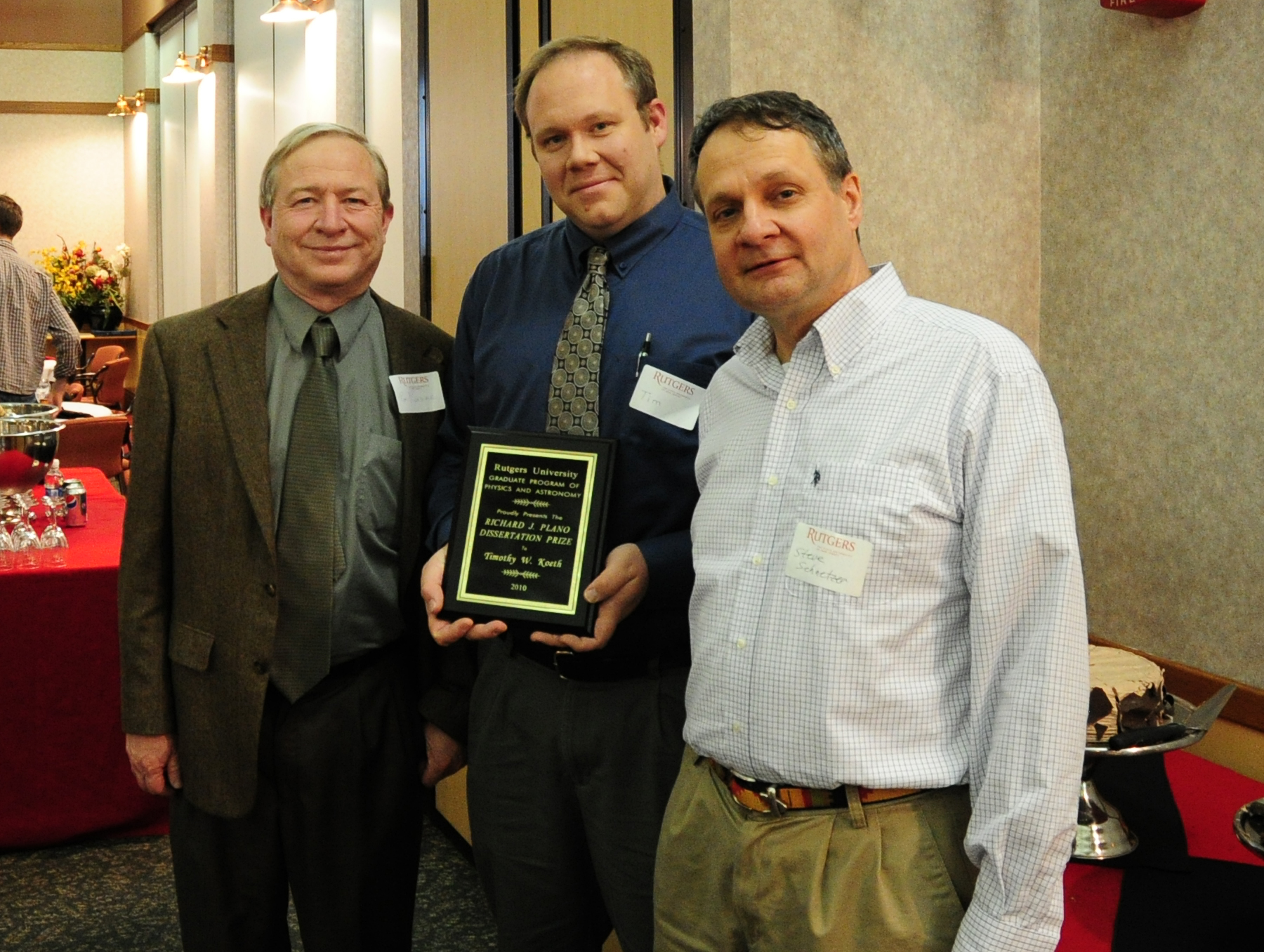 |
Tim Koeth receiving the Plano Dissertation Prize
at the Departmental Awards Banquet in April 2010, with
Professors Ron Ransome (l) and Steve Schnetzer (r) |
- 2009: Sourabh Dube
Advisor: Sunil Somalwar
Dissertation Title: Search for Supersymmetry at the Tevatron using the
Trilepton signature
- 2008: Elena Loginova
Advisor: Theodore Madey
Dissertation Title: Two topics in surface science: Morphological
changes of NiAl(111) induced by oxygen; Secondary electron yield
studies of Ru and TiO2 surfaces related to extreme ultraviolet lithography
- 2007: Craig Fennie
Advisor:Karin Rabe
Dissertation Title: Understanding the Interplay of Lattice and Magnetic
Degrees of Freedom in Structually Complex Insulators from First Principles
- 2006: Juntai Shen
Advisor:Jerry Sellwood
Dissertation Title: Dynamical Studies of Two Common Features in
Spiral Galaxies: Bars and Warps
- 2005: Namjung Hur
Adviser: Sang-Wook Cheong
Dissertation Title: Magnetoelectric and Magnetodielectric effects
in Multiferroic Manganites
- 2004: Cara Rakowski
Adviser: Jack Hughes
Dissertation Title: X-ray Studies of Supernova Remnants
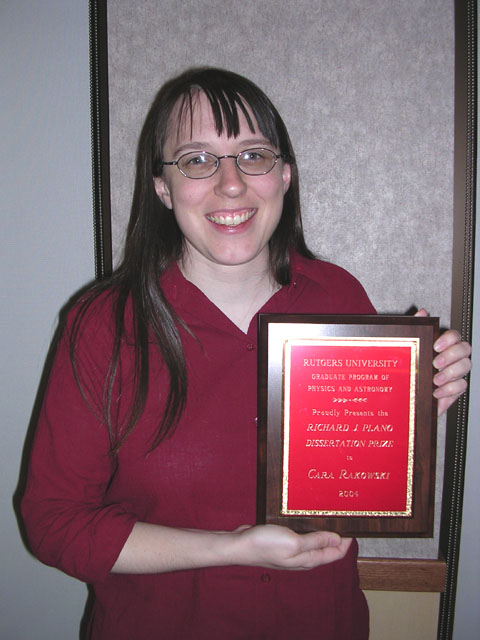 |
Cara Rakowski receiving the Plano Dissertation Prize
at the Departmental Awards Banquet in April 2004. |
- 2003: Vitaly Podzorov
Adviser: Michael Gershenson
Dissertation Title: Influence of the Phase Separation on the
Transport Properties of the Charge Ordered Colossal Magnetoresistance
Manganites
- 2002: Lubos Motl
Adviser: Thomas Banks
Dissertation Title: Nonperturbative Formulations of Superstring Theory
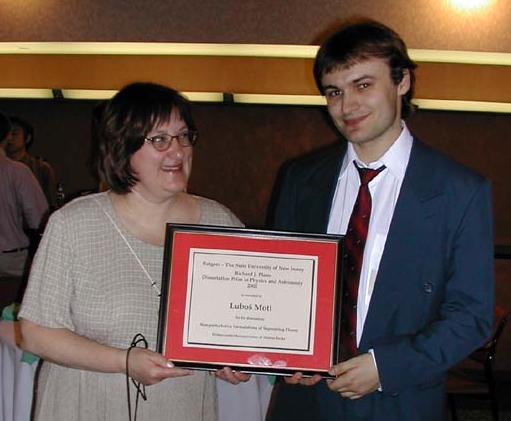 |
Prizewinner Lubos Motl (right) receiving the award from Graduate
Program Director Prof. Jolie Cizewski (left)
at the April, 2002, Departmental Awards Banquet. |
- 2001: Panayotis Kevrekidis
Advisers: Joel Lebowitz (Physics and Astronomy) and Panos Georgopoulos (EOHSI)
Dissertation Title: Lattice Dynamics of Solitary Wave Excitations
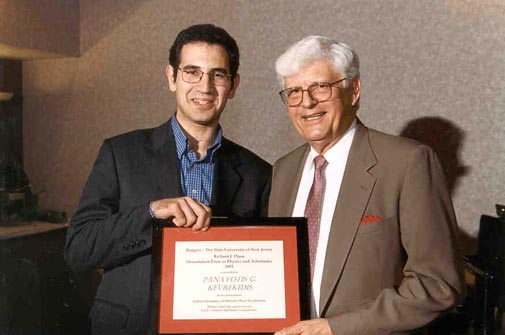 |
Prizewinner Panayotis Kevrekidis (left) and Prof. Richard Plano (right)
at the Departmental Awards Banquet in April, 2001. |

This page is maintained by
Prof. Ronald Gilman.
Last updated May 1, 2025.
